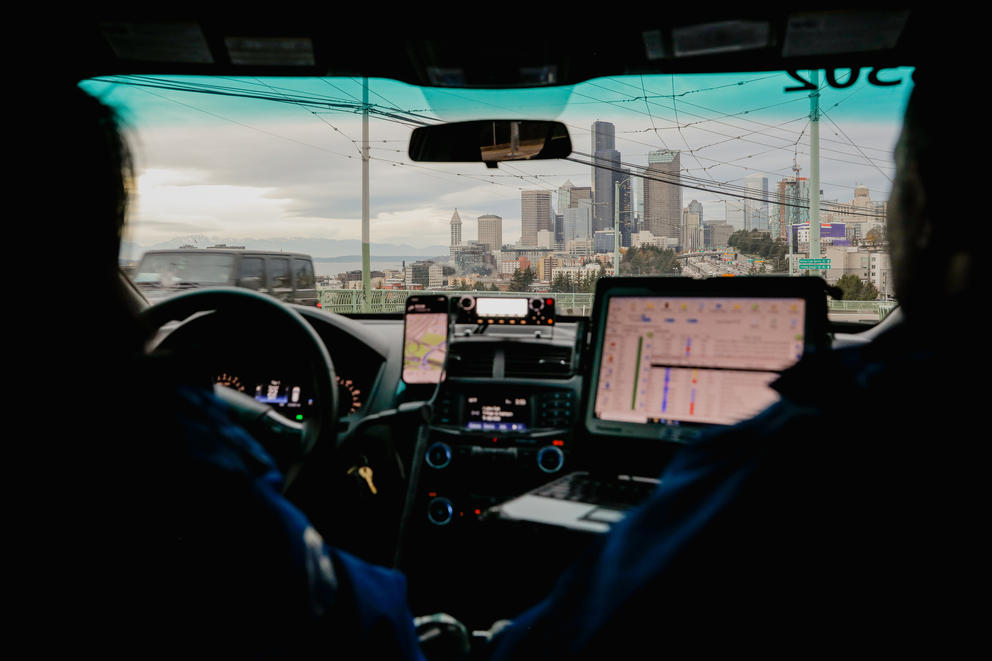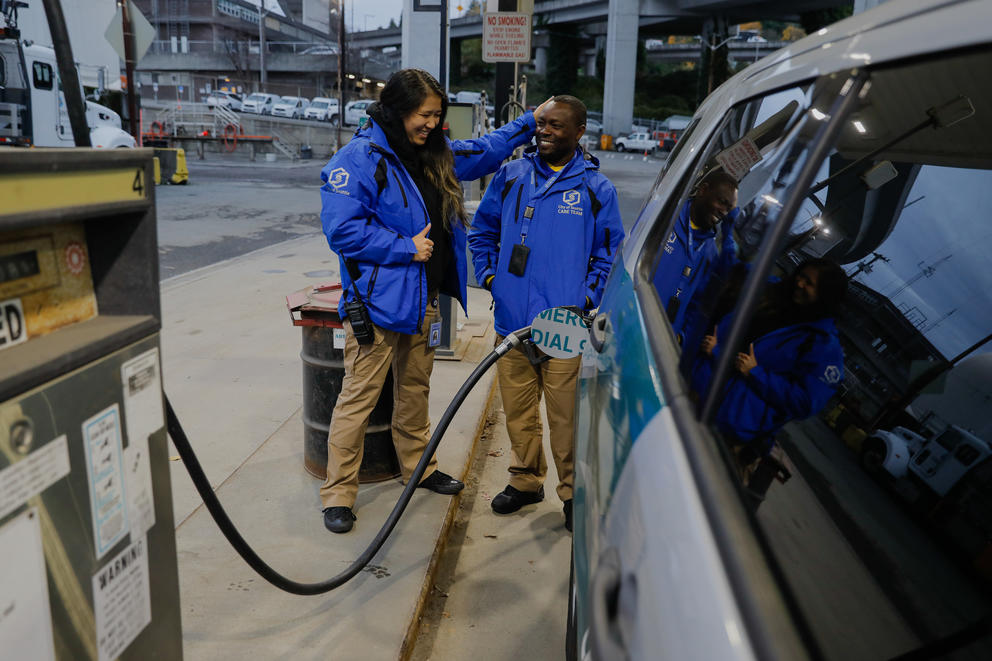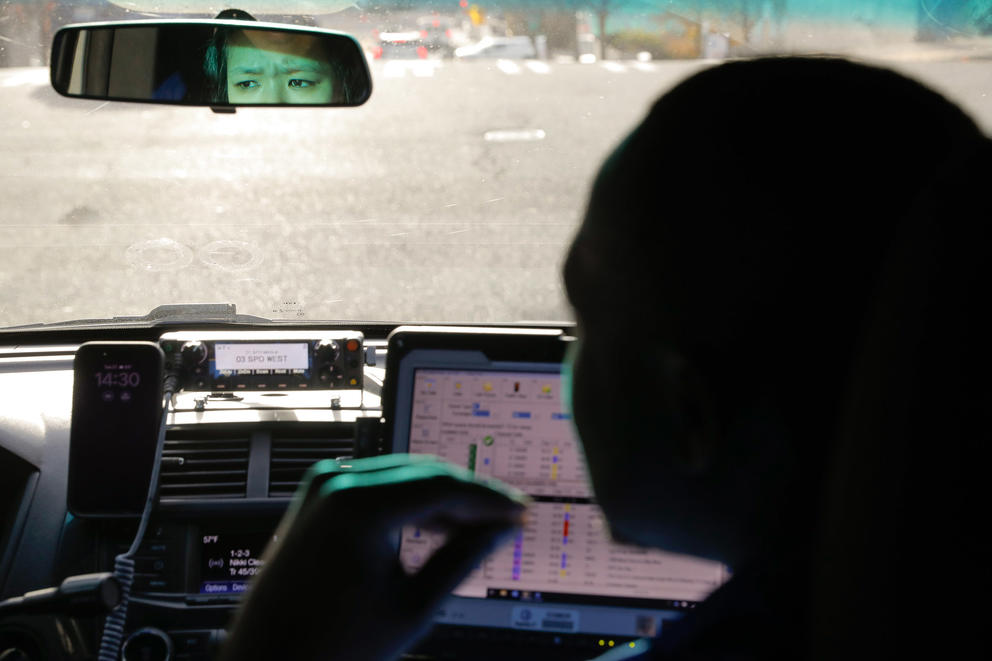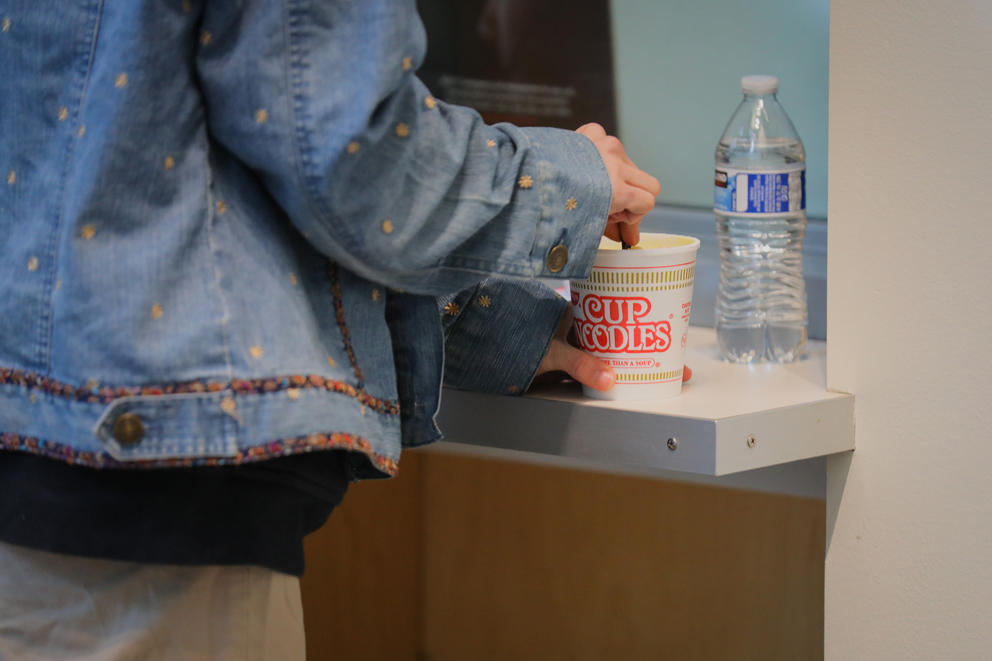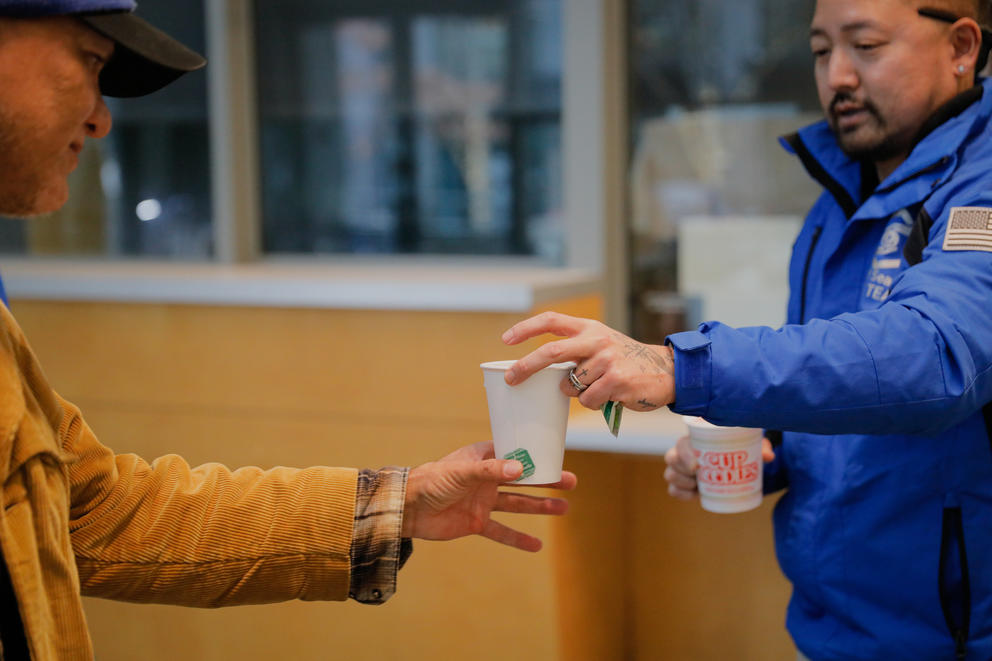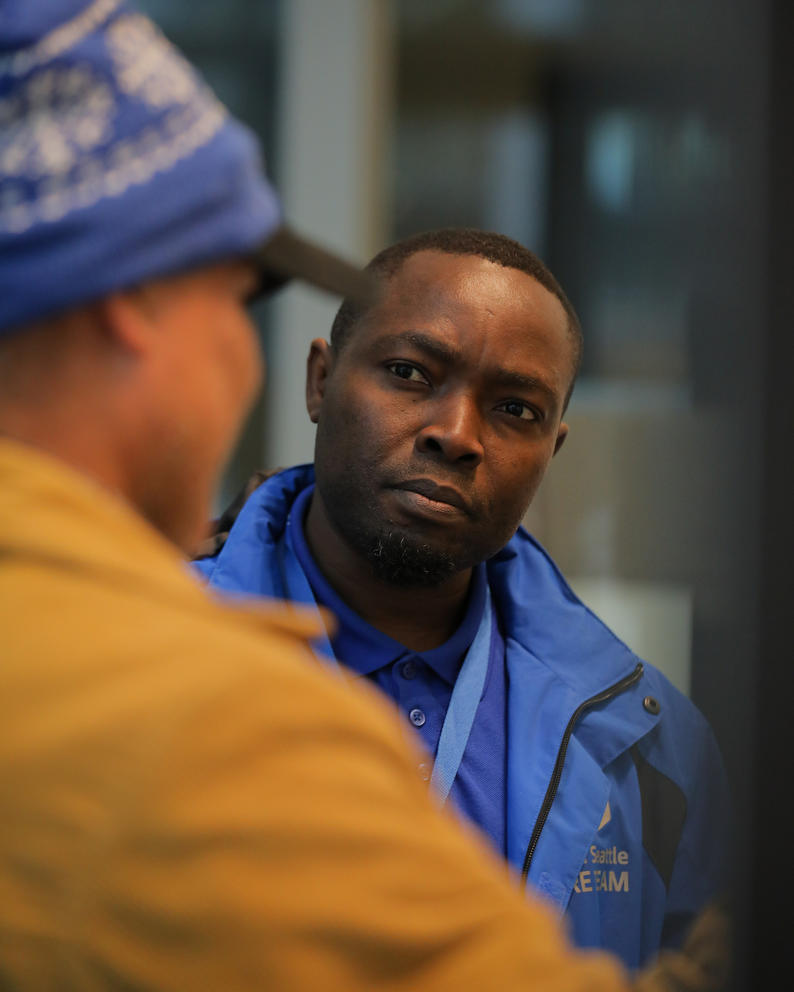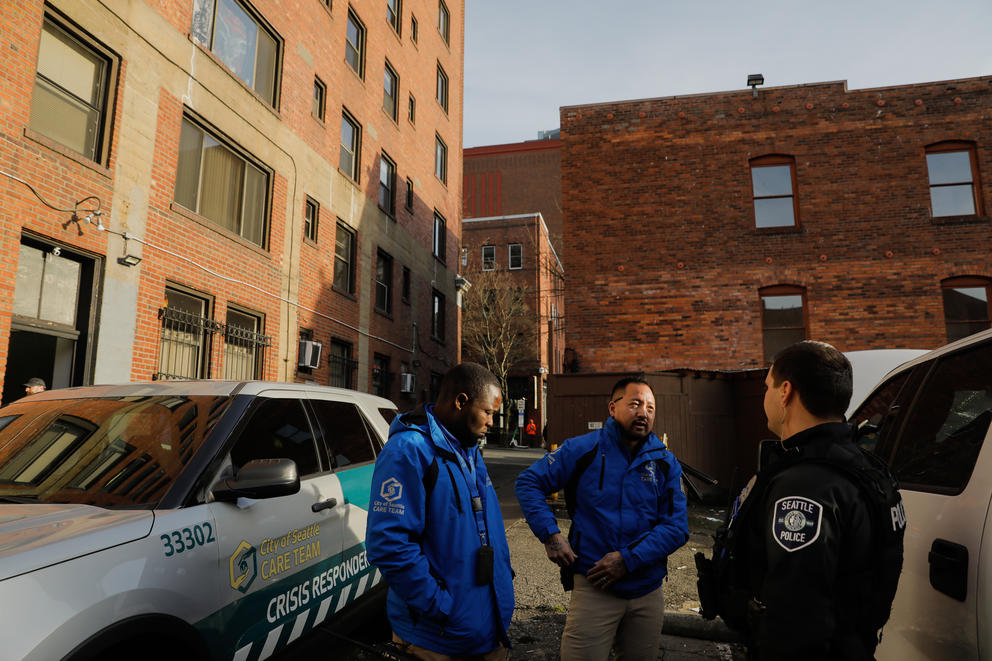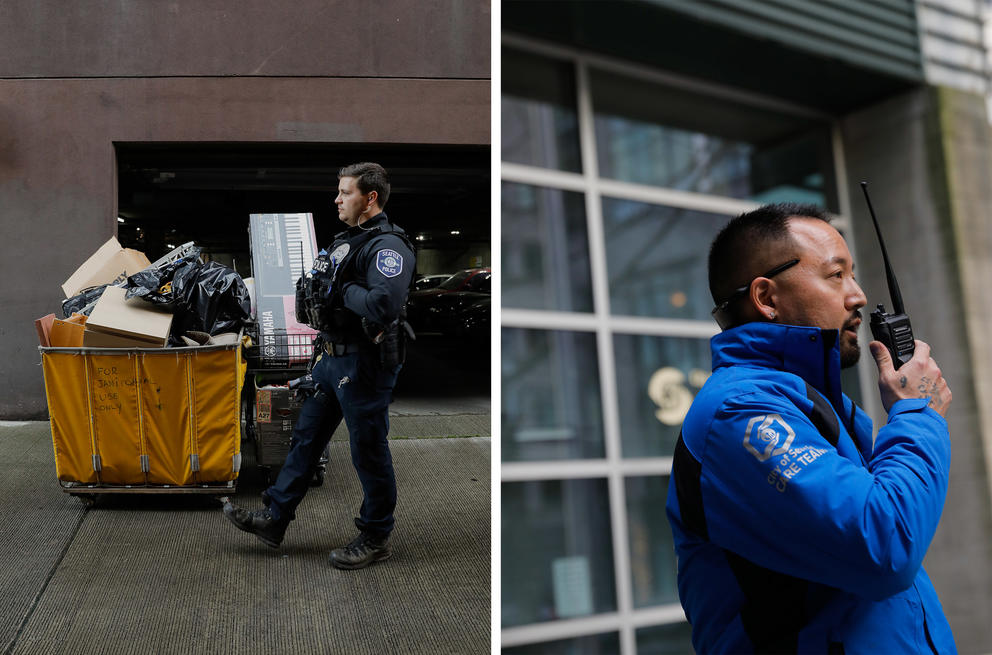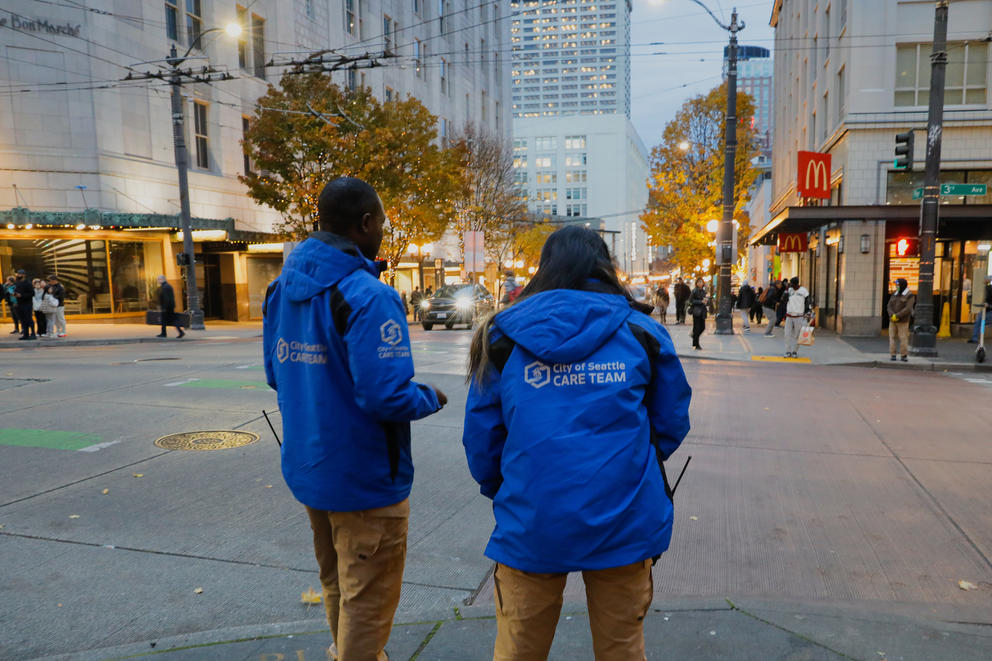Two patrol officers were alerted and stopped to talk to the woman: Did she have anywhere to go? Any family or friends who could take her in? But she remained adamant about returning to her home, even as a tow truck came to remove her car from the building’s private garage. She said she’d stay outside the building all night, waiting for staff to accept her apology and let her in.
The woman, who said she’d lived in the building for 20 years, wasn’t committing a crime. She didn’t appear to be a threat to anyone, including herself. But she needed to understand she had just lost her home and needed a place to stay for the night. The officers who stopped to talk to her didn’t have the time it would take to effectively communicate this to the woman, and they had other, more pressing emergencies to attend to.
Enter Seattle’s newest public safety department, the Community Assisted Response and Engagement, or CARE, Team. This eviction is one example of the mental and behavioral health crises that fall under CARE’s jurisdiction.
The team has worked since late October to aid people who can’t help themselves, making sure those with the right skills are meeting their needs and freeing police officers to focus on crime and public safety. This new approach to crisis response is part of the Seattle Police Department’s pivot in recent years, partly in response to the Black Lives Matter protests following the Minneapolis police killing of George Floyd.
The city’s new “dual dispatch” pilot program sends the CARE Team to answer calls in which there is no threat of violence and no medical emergency, but appear to involve a mental or behavioral health crisis. The CARE Team is dispatched simultaneously with police officers for 911 calls that appear to require the intervention of a crisis responder with mental health expertise. At the scene, the police officers first make sure the situation is safe for the CARE Team to engage before departing to attend to other, higher-priority calls.
“We’ve seen in Seattle and throughout this country situations where police are called, firefighters are called [and they don’t] have the strongest skill set for what we want to get done. Often we don’t need a gun and badge,” said Mayor Bruce Harrell at a press conference on Oct. 25, the day the CARE team soft-launched. “We need people trained and skilled in the kind of outreach and kind of treatment that we want to see. This dual dispatch pilot is exactly that.”
A response to Black Lives Matter and police brutality
As the city’s third public safety department, CARE has all the makings of one: an acting chief, Amy Smith, who was sworn in by the City Council, and access to the same systems and information as SPD and SFD. But there are key differences: the CARE Team does not have the power to forcibly remove a person from a location or force entry into a home — and they’re unarmed. The goal is to decriminalize mental health issues — to confront individuals in crisis by de-escalating, giving them someone to talk to and providing resources.
Smith recognizes that these crises are complex and it would be impossible to understand and resolve each one in the city. “But if we form a team and scale a team that can take lots of different lenses to it … there's going to be a higher likelihood that I can meet you where you are,” she said.
Smith is from Washington, but was living in Cincinnati when the Black Lives Matter movement exploded after a Minneapolis police officer murdered George Floyd. Activists across the nation called for defunding the police and creating alternative crisis response systems.
“I had been around social justice issues — certainly around the question of mental health and self determination,” Smith said. “When are we criminalizing something? When are we actually intervening and insisting on services so that somebody can get better?”
In August 2020, in the wake of local BLM protests and allegations against police officers, the Seattle City Council passed Resolution 31962, co-sponsored by former Councilmembers Debora Juarez, Lisa Herbold and Andrew Lewis, establishing the intent to create a third public safety department led by civilians. The resolution also approved a budget adjustment that would remove the 911 Call Center from SPD. The result is the CARE Department, including the CARE Team and the emergency call center.
Smith, who comes from an academic background with a master’s degree in ethical leadership and a doctorate in education for educational learning, was aware of Seattle’s other alternative crisis intervention programs before getting involved with CARE. SPD has its Crisis Response Team and the nonprofit Downtown Emergency Service Center has its Mobile Crisis Team. So, she asked herself, what would make the dual dispatch pilot different? What was it trying to solve? She spoke with academics and practitioners at places like Georgetown University and New York University to research what made this kind of program successful, and what set them up for failure.
“There was one thing that I started to hear consistently, which is, ‘If you do not do this with police, it will fail. It will not work,’” Smith said. “I am absolutely adamant that [first responders] are designing this together.”
Other cities are also experimenting with this approach — they’ve been popping up all over the country. Smith said Seattle’s model was influenced by the HEART program in Durham, North Carolina, and a community safety program in Albuquerque, New Mexico, but there are also alternative response units in other major cities like New York City, Los Angeles and Atlanta.
A day of crisis intervention
At their temporary office at the Seattle Municipal Tower, CARE Team community crisis responders Abdillahi Mohamed and Chris Inaba are prepared for a long day at work from 11 a.m. to 11 p.m.
Before getting into the CARE vehicle — a Ford Explorer with teal accents and the department’s logo of two hands surrounding the Space Needle — Mohamed and Inaba stock up on supplies: blankets, water bottles and Cup O’Noodles. A lot of their work involves providing people with things they don’t have, like food, shelter, clothing and sometimes transportation.
“I don’t see only a job, but I see [we] are helping the most vulnerable people,” Mohamed said.
Mohamed previously worked as a human rights activist, where he advocated for health care and freedom from violence for refugees. Each responder comes to the job from a different background. Inaba was previously a supervisor for SPD’s Community Service Officers unit, a team of outreach specialists who worked to provide at-risk individuals with housing, health care and treatment. Others are certified mental health professionals or have backgrounds in social work or crisis intervention.
That diversity was intentional, Smith said. “When I was interviewing the crisis responders, one of the candidates who was hired said, ‘Well, Amy, you can’t be competent in somebody else’s culture.’ And I thought that was just brilliant,” Smith said. “If I’m either clinically trained, or I have similar experiences, or I speak the same language — I understand something about what it is to be you.”
Prior to the team’s soft launch, the crisis responders rode along with first responders and shadowed them. Then they started to work in the field, riding in their own separate vehicles (unlike SPD’s Crisis Response Team, which pairs a mental health professional with a crisis intervention-trained officer as partners in a police car) but could be requested only by patrol officers. As of late November, they can officially be dispatched by the emergency call center.
According to Inaba, the majority of the calls the CARE Team receives are from people at risk of or experiencing homelessness, although they’re also occasionally called for domestic disputes, cases of child neglect and other issues. Africatown Community Land Trust, an organization that focuses on creating housing and commercial spaces for Black and African American people, said that the alternative response from the CARE Team is a better idea than having only a police response.
“A lot of the guys here have expressed that they’re threatened by the police,” said Clenna Brooks-Pope, an advocate supervisor at Benu Community Home with Africatown.
“They don’t look at [the police] as a resource,” Brooks-Pope said. “And then a lot of them have trauma because they’ve been in prisons and been treated unfairly inside the prisons, and the lack of resources there. It’s triggering. We try not to allow police to come up on the living floors, just because small things like hearing their keys jingle or their radios go off, can be triggering.”
Right now, the CARE Team’s jurisdiction is limited to Downtown, and only two responders paired in one car are in the field at a time. If the pilot is successful, the hope is that the team will expand to other parts of the city, and possibly increase in number.
Prior to the call Mohamed and Inaba got regarding the woman being evicted, they had two others. The first involved a woman who was undressed outside of the SPD West Precinct and in need of shelter, so they provided her with clothing and requested a vehicle to a local shelter to transport her to a day center, where she could wait for the shelter to open at 5 p.m. The second involved a woman who had taken a shower with her clothes on and an acquaintance walked her to the police department. Again, Mohamed and Inaba provided her with clothing and food. They confirmed that she had somewhere to spend the night and recommended other resources to her and her acquaintance.
“The partnership with our community partners is so important because we’re all one team,” Inaba said. “Our job is to connect people to those resources and we can’t make it work without the partnership.”
This is exactly what they did when they were called to the eviction in Belltown. Two officers were already on the scene, trying to find shelters for the woman to stay at, but she wasn’t willing to go. Written between the lines of the CARE Team’s job description is getting help for people who don’t want to be helped without using force. Mohamed and Inaba were able to reserve a bed for her at the Downtown Emergency Service Center’s Crisis Solutions Center, but now came the hard part: convincing her to go.
“Let’s just take this one step at a time,” Mohamed kept telling her, as she continued to worry for the safety of her belongings, which were now in the alleyway.
For nearly three hours, Mohamed and Inaba gave this woman their full attention. They attempted to connect her with a nearby storage unit where she could safely store her belongings now strewn across the alley, but, still in shock and completely focused on returning to her apartment, she refused the offer. They spoke with the building’s property manager to advocate for her, but to no avail.
The uniformed officers eventually left to attend to a higher-priority call, and the CARE Team had to decline two calls. But they were committed to ensuring the woman would not spend the night outside.
After a lot of negotiating and waiting patiently as the woman rummaged through her belongings to determine what she’d have to part ways with, they got her in the car, drove her to the Crisis Solutions Center and let a case manager take over. In the end, despite her initial resistance, she thanked the CARE Team.
Left: SPD patrol officer Riley Caulfield walks past a bin containing the contents of a woman’s apartment in an alley in downtown Seattle after she was evicted from the building. Right: Inaba checks in with dispatch after responding to a call to help a woman in crisis. The CARE team works with SPD and other community partners to help people in crisis. (Genna Martin/Crosscut)
Looking to the future
After each dispatch, the CARE Team fills out a survey evaluating the experience. The survey asks about safety, if the call was appropriate for the CARE Team and how the responders are feeling afterward. Police officers fill out similar surveys after working with the team. Smith uses these to evaluate the effectiveness of the intervention and the team. Additionally, Seattle University researchers are studying and evaluating the pilot project.
The pilot is still in its early stages, but Smith and others are hopeful it will be a success.
“Rather than criminalizing and scandalizing and vilifying everyone, I think we just acknowledge that we’ve just got some really complex problems, but that we’re smart and resourceful, and we’re going to take care of one another,” Smith said. “Because what’s the alternative? Let it all fall apart? It’s not an option.”
Get daily news in your inbox
This newsletter curates some of the most important headlines of the day from Crosscut and other news outlets.


